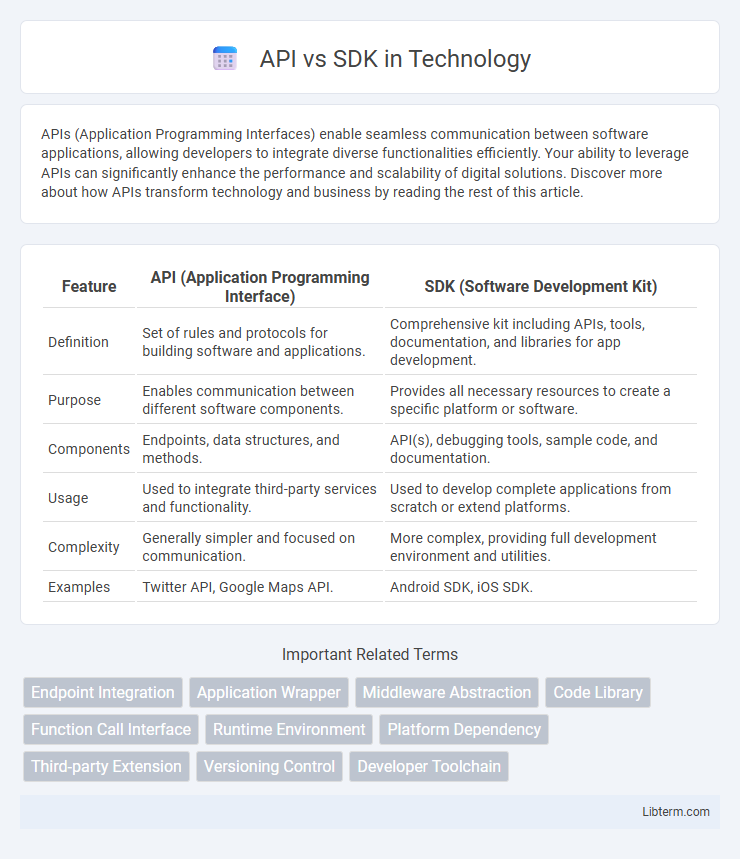APIs (Application Programming Interfaces) enable seamless communication between software applications, allowing developers to integrate diverse functionalities efficiently. Your ability to leverage APIs can significantly enhance the performance and scalability of digital solutions. Discover more about how APIs transform technology and business by reading the rest of this article.
Table of Comparison
| Feature | API (Application Programming Interface) | SDK (Software Development Kit) |
|---|---|---|
| Definition | Set of rules and protocols for building software and applications. | Comprehensive kit including APIs, tools, documentation, and libraries for app development. |
| Purpose | Enables communication between different software components. | Provides all necessary resources to create a specific platform or software. |
| Components | Endpoints, data structures, and methods. | API(s), debugging tools, sample code, and documentation. |
| Usage | Used to integrate third-party services and functionality. | Used to develop complete applications from scratch or extend platforms. |
| Complexity | Generally simpler and focused on communication. | More complex, providing full development environment and utilities. |
| Examples | Twitter API, Google Maps API. | Android SDK, iOS SDK. |
Understanding API and SDK: Definitions
An API (Application Programming Interface) is a set of protocols and tools that allow different software applications to communicate and interact with each other, providing predefined functions and data exchange methods. An SDK (Software Development Kit) is a comprehensive collection of software development tools, including APIs, libraries, documentation, code samples, and debugging utilities, designed to help developers create applications for specific platforms or environments. Understanding the distinction highlights that APIs enable functionality integration, while SDKs provide the complete toolkit needed to build software solutions.
Core Differences Between API and SDK
APIs define specific protocols and tools for building and interacting with software applications, enabling communication between different software components. SDKs are comprehensive suites that include APIs along with libraries, documentation, and tools designed to facilitate the development of applications for a particular platform. Core differences lie in scope: APIs offer a set of functions for interaction, while SDKs provide a full development environment.
How APIs Work: Key Functionalities
APIs (Application Programming Interfaces) enable software applications to communicate by exposing specific functionalities through defined endpoints, allowing requests and responses in standardized formats such as JSON or XML. They handle processes like authentication, data exchange, and error handling to facilitate seamless integration between disparate systems or services. By abstracting underlying code complexity, APIs allow developers to access features or data without needing to understand internal implementations.
Exploring SDKs: Components and Uses
SDKs (Software Development Kits) include a collection of tools such as libraries, documentation, code samples, and APIs that facilitate application development within a specific platform or framework. They provide developers with pre-built components and consistent environments to streamline coding, testing, and debugging processes. Incorporating SDKs accelerates software integration and enhances functionality by enabling seamless interaction with underlying system resources and third-party services.
Use Cases: When to Use APIs vs SDKs
APIs are ideal for integrating specific functionalities or data between different software systems, such as enabling third-party payment processing or social media sharing within an application. SDKs provide comprehensive development tools for building fully functional applications on specific platforms, including libraries, documentation, and debugging utilities, making them suitable for creating complex mobile apps or games. Use APIs when you need to connect and extend existing services, and turn to SDKs when you require a robust environment for end-to-end software development.
Benefits of Using APIs
APIs enable seamless integration between different software applications, allowing developers to access specific features or data without building functionality from scratch. They enhance scalability by allowing modular development and quick updates without affecting the entire system. Furthermore, APIs foster innovation through easy access to third-party services, accelerating time-to-market and reducing development costs.
Advantages of Implementing SDKs
Implementing SDKs enhances development efficiency by providing pre-built libraries, debugging tools, and comprehensive documentation, which streamline the integration process compared to using APIs alone. SDKs enable deeper access to platform-specific features and consistent updates, ensuring robust functionality and compatibility across applications. They also reduce development time and costs by offering ready-made components that accelerate coding, testing, and deployment cycles.
Common Challenges with APIs and SDKs
Common challenges with APIs and SDKs include version compatibility issues, where outdated SDKs may not support the latest API features, causing integration failures. Developers often face inconsistent documentation and lack of standardized error handling, leading to increased debugging time and implementation errors. Security concerns, such as improper authentication and data exposure, are prevalent, requiring rigorous testing and adherence to best practices to safeguard applications.
Choosing the Right Tool for Your Project
Choosing between an API and an SDK depends on your project requirements and development expertise. APIs offer specific functionalities through predefined interfaces, ideal for integrating external services with minimal overhead, while SDKs provide comprehensive development tools, libraries, and documentation for building applications from the ground up. Evaluating factors such as project complexity, customization needs, and platform compatibility ensures you select the most efficient tool that accelerates development and optimizes performance.
Future Trends in API and SDK Development
API and SDK development is rapidly advancing with increased emphasis on cloud-native integrations and AI-powered automation tools, enabling developers to build more scalable and intelligent applications. The rise of GraphQL and RESTful APIs combined with modular SDKs offers enhanced flexibility and faster deployment cycles across various platforms. Embracing microservices architecture and enhanced security protocols ensures APIs and SDKs remain robust and adaptive to evolving digital ecosystems.
API Infographic

 libterm.com
libterm.com